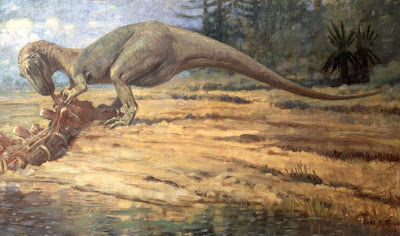Kong-blogging, essay 6 of 15 blog entries on
Skull Island in King Kong (1933)
Part One, A Charles R. Knight Dinosaur Gallery
Part Two, Knight Paintings in Motion
Part One, A Charles R. Knight Dinosaur Gallery
 |
| Tyrannosaurus confronts a family of Triceratops by Charles R. Knight, circa 1919. Source: Wikimedia Commons |
 |
| Trachodons by Charles R. Knight, circa 1905. Source: Wikimedia Commons |
 |
| Nesting Protoceratops from Charles R. Knight's murals for the Field Museum of Natural History, circa 1925. Source: Wikimedia Commons |
 |
| Jurassic scene with Archaeopteryx, Compsognathus, and Rhamphorynchus from Charles R. Knight's murals for the Field Museum of Natural History. Source: Wikimedia Commons |
 |
| Allosaurus eating a Brontosaurus by Charles R. Knight, circa 1904. Source: Wikimedia Commons |
Part Two, Knight Paintings in Motion
At this point, we reach an artist whose work had a profound
impact upon King Kong (1933) and whom
I view with awe. Charles R. Knight’s
dinosaurs look like real animals, fully alive in the moment and informed by
individual personalities. Many great
paleoartists have followed the path blazed by Knight, but this isn’t a case where they
could see further for standing on the shoulders of a giant. In certain important respects, Knight remains the unsurpassed master.
As a boy, Charles R. Knight (1874-1953) had special access
through his father to the backrooms of the American Museum
In 1894 when Knight was still a very young man, a friend at
the American Museum of Natural History recommended him for an assignment to depict an Elotherium, an extinct pig-like
animal. Knight’s painting was exactly
what the museum wanted. It was
scientifically accurate and artistically exciting. Henry Fairfield Osborn, president of the
museum, took Knight under his wing, convinced that his artwork could
communicate the wonder of prehistoric life to the museum’s public.
By the time that Willis O’Brien and Marcel Delgado teamed up
in 1924 to create the dinosaur models for the movie of The
Lost World, Charles R. Knight had achieved a high reputation for his depictions of prehistoric life both at the American
Museum
There was an interesting symmetry in the complementary work
of Knight and Delgado. When working on a
figure, Knight would often begin by determining the skeletal and muscular form
of the animal and then he would sculpt a three-dimensional model. He said this was important to see how shadows
would naturally fall. Only after gaining
a thorough understanding of the sculpture would Knight embark on his
painting. Now… reversing this process, Delgado began with Knight's paintings, studying them to identify what the skeletal and muscular forms must
have been. In a way, Delgado's three-dimensional models returned the
paintings back to their sculptural beginnings.
In the eight years between The Lost World (1925) and King Kong (1933),
Knight received one of his greatest commissions, enabling him to paint a
spectacular series of murals for the Field Museum of Natural History in Chicago
Many decades later, Willis O’Brien’s protégé Ray Harryhausen
(who went on to become the greatest stop-motion animator of his generation)
expressed his own feelings about Knight’s legacy. “His dinosaur and prehistoric animal
paintings and sculptures had more than just a realistic surface quality; they
also possessed scientific reality and natural beauty. He was the first to reconstruct prehistoric
life in a romantic form and the first to work in close collaboration with paleontologists
to attempt to achieve scientifically accurate anatomy. His long experience in drawing and painting
live animals in zoos, together with his romantic and vivid imagination, helped
to instill his prehistoric reconstructions with a ‘charisma’ only found in
living creatures...”
Equally miraculous, Marcel Delgado and Willis O’Brien
somehow caught that ‘charisma’ and transferred it to film, creating magical
images of Knight’s dinosaurs in motion.
Part Three, Comparisons
Reference Sources
Watch King Kong...
Part Three, Comparisons
 |
| Charles R. Knight's 1897 painting of an Agathaumus (based on bones later identified as Triceratops). Source: Wikimedia Commons |
 |
| A dinosaur cut from the final release of King Kong. A Styracosaurus, looking very similar to Knight's Agathaumus, chases sailors onto the log. |
 |
| A detail of Charles R. Knight's Tyrannosaurus painting from the gallery above, showing the family of Triceratops. |
 |
| Marcel Delgado's models of a parent and baby Triceratops from The Lost World (1925). |
 |
| Charles R. Knight with his working model of a Stegosaurus. Source: Wikimedia Commons |
 |
| Willis O'Brien with Marcel Delgado's model of a Styracosaurus (ultimately not seen in the final cut) for King Kong. |
Reference Sources
The Making of King Kong by Orville Goldner and George E. Turner
Living Dangerously: The Adventures of Merian C. Cooper by Mark Cotta Vaz
Willis O'Brien: Special Effects Genius by Steve Archer
Dinosaurs Past and Present, Volume 1, Natural History Museum of Los Angeles County
Dinosaurs Past and Present, Volume 2, Natural History Museum of Los Angeles County
Charles R. Knight: The Artist Who Saw Through Time by Richard Milner
All in the Bones: A Biography of Benjamin Waterhouse Hawkins by Valerie Bramwell and Robert M. Peck
Special features on the two-disc special edition, King Kong (1933) by Warner Home Video Inc.
Special features on the two-disc special edition, King Kong (1933) by Warner Home Video Inc.
... and an occasional sneak glance at Wikipedia entries (but always double-checking everything!)
Watch King Kong...
Purchase a King Kong DVD or Blu-Ray set at Amazon or Barnes & Noble.
Rent King Kong at Netflix or other rental service.
© 2012 Lee Price
Rent King Kong at Netflix or other rental service.
© 2012 Lee Price

Excellent writeup. The Agauthaumas in "The Lost World" and the Tyrannosaurus in "King Kong" are clear connections between O'Brien and Knight. Harryhausen said that Knight provided so much influence and inspiration and is one of his favorite artists
ReplyDelete